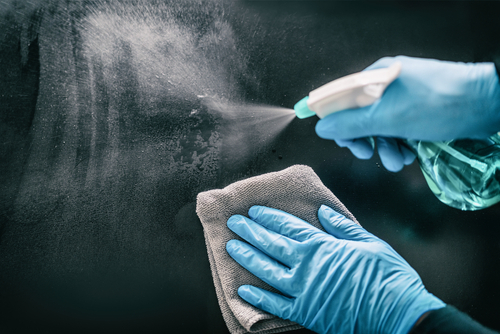Many building owners and managers realized when the COVID-19 pandemic arrived that they were not well versed in the rudiments of cleaning and disinfecting. In fact, many believed the two were the same, even interchangeable. That is not the case.

In some instances, steps were taken to prevent the spread of COVID-19 that later proved to be ineffective. Either the wrong cleaning solution, sanitizer, or disinfectant was used, or it was not used properly.
Even though the pandemic appears to be moving behind us, building owners and managers must remain vigilant and should have a solid understanding of what cleaning and disinfecting are all about. After all, the professionals’ job, now more than ever before, is to take steps to ensure the health and safety of their tenants and other building users.
With that said, consider the following a “primer” on these products and their use. The more that building owners and managers understand what these products are and how they should be used, the more effective the professionals will be at protecting human health.
The first thing we need to clarify is cleaning. Cleaning can be defined as the removal of soils, contaminants, and even pathogens from surfaces.
During the pandemic, the Centers for Disease Control and Prevention (CDC) reported that in most situations, cleaning using just water and an effective cleaning agent likely was all that was needed to keep surfaces healthy and remove the pathogen that caused coronavirus.
However, in almost all cases, before a sanitizer or disinfectant can be used, the surface must be cleaned first. By removing soils from the surface, a sanitizer or disinfectant will be more effective.
With this understood, here are some additional facts building owners and managers should know about these products:
Sanitizers
Before COVID-19, sanitizing was all that was considered necessary to protect the health of building users. A sanitizer reduces the number of pathogens on a surface to what is regarded as a safe level for public health. Sanitizers are also less costly than disinfectants (which we will discuss next) and easier to use.
Disinfectants
Whereas a sanitizer reduces the number of pathogens on a surface, a disinfectant eliminates (or kills) pathogens on a surface. However, there are some caveats. For instance, not all disinfectants are engineered to eliminate every type of pathogen. The product label will indicate which pathogens it is designed to eliminate when used properly. These are referred to as “kill claims.”
Very often, building owners and managers will not know what types of pathogens are on the surface. They just know that the surface should be disinfected. In such cases, a “general,” or “broad range,” disinfectant should be used.
During the pandemic, the U.S. Environmental Protection Agency helped us make our disinfectant selection. The organization compiled a list of disinfectants proven to effectively eliminate the coronavirus, referred to as “List N.”
Our primer must include a few more critical points about disinfectants and their use.

For instance, disinfectants must dwell on surfaces for a few minutes before being wiped away. This ensures a disinfectant is effective. The dwell time will be listed on the product label.
However, should the disinfectant dry while on a surface, the entire surface must be cleaned again, and the disinfectant reapplied.
And two more things—we already mentioned that there are general or broad-range disinfectants. There are two more types of disinfectants that building owners and managers should be aware of.
A limited disinfectant is designed to be effective only against a specific group of microorganisms or pathogens. For instance, some disinfectants are designed to be effective primarily against the microorganisms that cause the norovirus.
Another type of disinfectant is a hospital-grade disinfectant. These disinfectants have proven effective at eliminating many types of nosocomial (healthcare-acquired) bacterial pathogens. As the name implies, they are generally used in hospitals, clinics, dental offices, or other healthcare-related facilities.
More Points
To ensure our primer is complete, there are some more things to discuss about sanitizers and disinfectants. Among these are the following:
Costs. When selecting sanitizers or disinfectants, it is especially important not to make the selection based on the product’s price. The “sticker price” may have nothing to do with what the product actually costs to use. To determine value for money, check the dilution ratios. More water and less disinfectant is more cost-effective.
Corrosive. Some sanitizers and disinfectants may prove corrosive to metalworks. Be aware of this and test the product first before extensive use.
Immunity. Pathogens can become immune to certain disinfectants just as we can become immune to certain antibiotics. To address this, use different types of disinfectants from different manufacturers. They typically will have different ingredients or a different mixture of ingredients to help prevent pathogen immunities.
Mixing. Never mix two different sanitizers or disinfectants together.
Dilution. The product’s dilution ratios will be clearly posted on the label. These must be adhered to. Too much chemical or too little chemical can impede sanitizing and disinfecting effectiveness.
“Quats.” Quat binding occurs when the key ingredients in a disinfectant become absorbed into a cleaning cloth or mop, reducing the effectiveness of the disinfectant. One way to prevent this is to always spray the disinfectant on the surface to be cleaned, not on the cloth. Also, change both the cloth and the mop head frequently.
As you can see, there is a lot to know about cleaning, sanitizing, and disinfecting. Building owners and managers should also be aware of one more thing: Do not go it alone.
Astute janitorial distributors can be walking encyclopedias when it comes to cleaning, sanitizing, and disinfecting. Furthermore, they have really proven their value for many building owners and managers during the pandemic.
This is because they have helped guide owners and managers into selecting specific products and disinfecting technologies proven to help stop the spread of the virus, keep people healthy, and–what is most important now–keep facilities open and operating.
Michael Wilson is Vice President of Marketing and Packaging for AFFLINK, a global leader in supply chain optimization, packaging, and marketers of advanced cleaning products and technologies that minimize the spread of infection.
